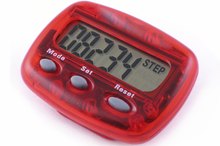How to Calculate Calories Burned Per Sit Up Based on Weight
In working out and trying to lose weight, one of the main ways to monitor your progress is by keeping track of the calories you burn. A very common calorie-burning exercise is the sit-up, also called the crunch. Depending on one's weight, an individual can burn between 400 and 800 calories per hour doing fast, vigorous sit-ups. Calculating the amount of calories burned per hour doing sit-ups is quick and easy.
Determine the number of sit-ups you can perform in 1 minute. Follow the pace of your normal workout.
How Many Calories Burned with Biggest Loser DVD?
Learn More
Calculate the number of calories you burn per minute performing sit-ups. As a baseline, a 100-pound individual burns 6 calories per minute doing sit-ups. For every 10 pounds more you weigh, add 1 calorie per minute. For example, a 110-pound individual burns 7 calories per minute, a 120-pound individual burns 8 calories per minute, and so on.
Divide the number of calories you burn per minute of sit-ups by the number of sit-ups you can perform in 1 minute. This is the number of calories you burn per sit-up 1. For example, here is the calculation for a 120-pound individual: 8 calories per minute / 30 sit-ups per minute = 0.27 calories per sit-up.
Tips
Visit a free calories-burned tool online, such as the one at http://www.fatburn.com/free_tool_activity_burn.asp, for quick and easy calculations.
Warnings
Always check with your doctor before beginning any new exercise program.
Related Articles
References
- Free Activity Burn Tool
- Chang WD, Lin HY, Lai PT. Core strength training for patients with chronic low back pain. J Phys Ther Sci. 2015;27(3):619-22.
- Akhtar MW, Karimi H, Gilani SA. Effectiveness of core stabilization exercises and routine exercise therapy in management of pain in chronic non-specific low back pain: A randomized controlled clinical trial. Pak J Med Sci. 2017;33(4):1002-1006.
- Hsu SL, Oda H, Shirahata S, Watanabe M, Sasaki M. Effects of core strength training on core stability. J Phys Ther Sci. 2018;30(8):1014-1018. doi:10.1589/jpts.30.1014
- Hung KC, Chung HW, Yu CC, Lai HC, Sun FH. Effects of 8-week core training on core endurance and running economy. PLoS One. 2019;14(3):e0213158. Published 2019 Mar 8. doi:10.1371/journal.pone.0213158
- Huxel Bliven KC, Anderson BE. Core stability training for injury prevention. Sports Health. 2013;5(6):514-522. doi:10.1177/1941738113481200
- Reed CA, Ford KR, Myer GD, Hewett TE. The effects of isolated and integrated 'core stability' training on athletic performance measures: a systematic review. Sports Med. 2012;42(8):697-706. doi:10.2165/11633450-000000000-00000
- Sharrock C, Cropper J, Mostad J, Johnson M, Malone T. A pilot study of core stability and athletic performance: is there a relationship?. Int J Sports Phys Ther. 2011;6(2):63-74.
Tips
- Visit a free calories-burned tool online, such as the one at http://www.fatburn.com/free_tool_activity_burn.asp, for quick and easy calculations.
Warnings
- Always check with your doctor before beginning any new exercise program.
Writer Bio
Emilie Dennington has been writing about health and communication since 2008. Her work has appeared in public service announcements as part of an urban-health campaign, as well as at the 2011 International Communication Conference. Dennington holds a Master of Arts in communication from the University of Wisconsin-Milwaukee.








